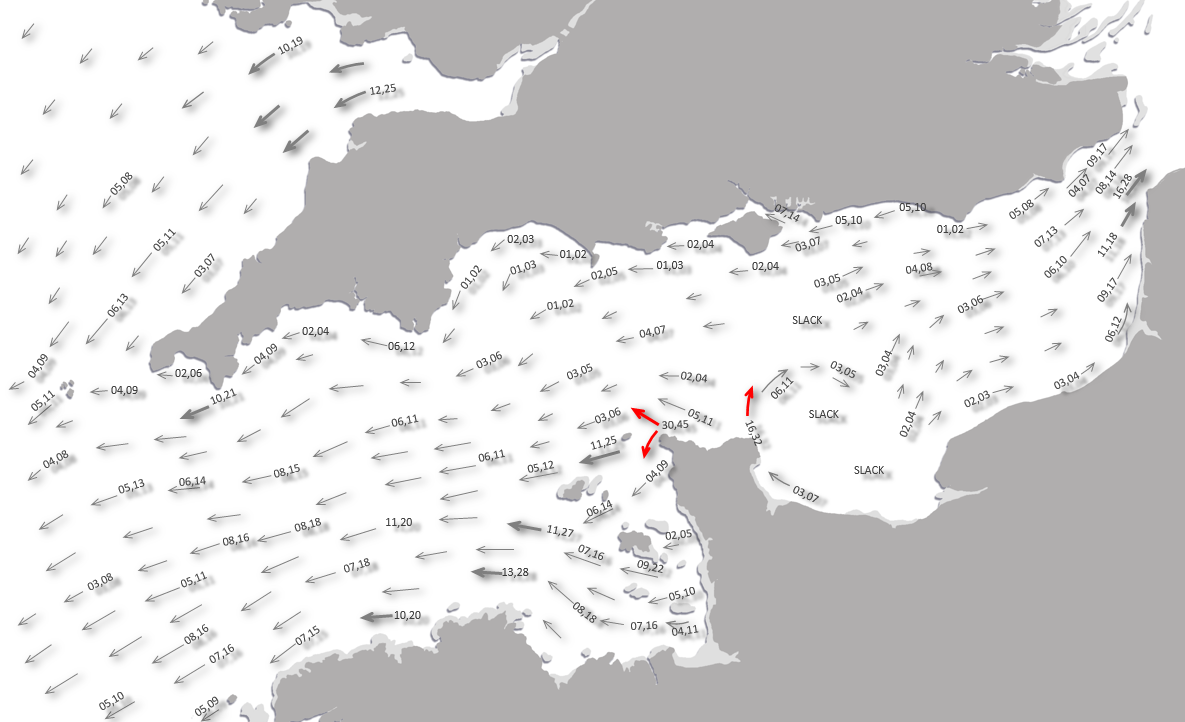_england_Devon & Beyond from above.jpg)
This a tolerable anchorage and very pleasant in any moderate winds with a westerly component. Access is straightforward as a central path presents no danger. A measure of caution is required when anchoring to avoid a historic wreck that lies in its northwest corner.
Keyfacts for Starehole Bay
Facilities


Nature






Considerations
Protected sectors
Approaches


Shelter


Last modified
December 21st 2018 Summary
A good location with straightforward access.Facilities


Nature






Considerations
Position and approaches
Expand to new tab or fullscreen
Haven position
 50° 12.803' N, 003° 47.149' W
50° 12.803' N, 003° 47.149' WThis is in the southwest end of the bay on the 2-metre contour.
What is the initial fix?
The following Salcombe Initial Fix will set up a final approach:
 50° 12.421' N, 003° 46.666' W
50° 12.421' N, 003° 46.666' W What are the key points of the approach?
Offshore details are available in southwestern England’s coastal overview from Start Point to Lizard Point 

- Use the Salcombe Initial Fix from the west to safely round Bolt Head and stand well off the Mew Stone to avoid its eastward extending dangers.
- Vessels approaching from the east, after clearing Prawle Point it is safe to ignore the initial fix and steer for the centre of the bay.
- Stay clear of the wreck of the barque Herzogin Cecilie located in the northwest corner and the submerged Cadmus Rocks south of Great Eelstone.
Not what you need?
Click the 'Next' and 'Previous' buttons to progress through neighbouring havens in a coastal 'clockwise' or 'anti-clockwise' sequence. Below are the ten nearest havens to Starehole Bay for your convenience.
Ten nearest havens by straight line charted distance and bearing:
- Salcombe - 0.8 nautical miles NNE
- Hope Cove - 3.5 nautical miles WNW
- Kingsbridge - 4 nautical miles N
- Hallsands - 5.1 nautical miles ENE
- River Avon - 5.1 nautical miles NW
- River Erme - 8.5 nautical miles NW
- Dartmouth Harbour - 11.5 nautical miles NE
- River Yealm - 11.8 nautical miles WNW
- Dittisham & The River Dart - 12.5 nautical miles NE
- Brixham - 15.6 nautical miles NE
These havens are ordered by straight line charted distance and bearing, and can be reordered by compass direction or coastal sequence:
- Salcombe - 0.8 miles NNE
- Hope Cove - 3.5 miles WNW
- Kingsbridge - 4 miles N
- Hallsands - 5.1 miles ENE
- River Avon - 5.1 miles NW
- River Erme - 8.5 miles NW
- Dartmouth Harbour - 11.5 miles NE
- River Yealm - 11.8 miles WNW
- Dittisham & The River Dart - 12.5 miles NE
- Brixham - 15.6 miles NE
Chart
What's the story here?
 Yacht anchored in Starehole Bay
Yacht anchored in Starehole BayImage: Michael Harpur
Starehole Bay is a small southeast facing bay that lies at the southern tip of Devon, immediately northwest of Bolt Head. It is at the mouth of the Kingsbridge Estuary and adjacent to the approaches to Salcombe. Surrounded by high cliffs the bay is formed between the furthermost points of Bolt Head and the Mew Stone to the southeast, and Great Eelstone to the northeast. It has a little tidal beach at its head with a small cove from which rocky spurs reach into the sea. The remains of the wreck of the barque Herzogin Cecilie lie in its northwest corner.
Well sheltered by its high cliffs the bay usually has flat water and ample depth.
How to get in?
 The view westward anchored in Starehole Bay
The view westward anchored in Starehole BayImage: Michael Harpur
 Use southwestern England’s coastal overview from Start Point to Lizard Point
Use southwestern England’s coastal overview from Start Point to Lizard Point  for seaward approaches. The primary dangers on the approach are rocks extending from Starehole Bays extremities. This is the foul ground extending out 100 metres eastward of the Mew Stone close to Bolt Head. Likewise the covered Cadmus Rocks lying about 120 metres south of Great Eelstone in the northeast corner of Starehole Bay. A central approach from the southeast presents no concern.
for seaward approaches. The primary dangers on the approach are rocks extending from Starehole Bays extremities. This is the foul ground extending out 100 metres eastward of the Mew Stone close to Bolt Head. Likewise the covered Cadmus Rocks lying about 120 metres south of Great Eelstone in the northeast corner of Starehole Bay. A central approach from the southeast presents no concern. When anchoring avoid the wreck of the barque Herzogin Cecilie which lies in the northwest corner of the bay. In the season a buoy is attached to where the bows of the wreck lie, so it should be readily apparent.
 Anchor according to draft and conditions in sand. Land by tender on its small tidal beach.
Anchor according to draft and conditions in sand. Land by tender on its small tidal beach.Why visit here?
Starehole Bay receives its name from the Gaelic word ‘stair’, meaning ‘place by’ stepping stones, with the ‘hole’ most likely describing the steep enclosed cove that such a pathway would descend into. Duchess Cecilie
Duchess CecilieImage: Michael Harpur
Herzogin Cecilie was interned in Chile for the duration of World War One and afterwards was allocated to France by the War Reparations Board. In 1921 the ship was sold to the Finnish Shipping tycoon Gustaf Eriksson of Mariehamn. At this time the tall ships still remained commercially competitive against the steamers on the longer trade routes such as from Australia carrying wheat grain to Europe. This became competitive when several tall ships tried to arrive first in Europe, to sell their cargo for a higher price, and the Great Grain Races then came into being.
The races would make the fast Herzogin Cecilie one of the most famous ships of her time. She won four times prior to 1921 and won three times in ten trips from 1926 to 1935. So, in 1935, the captain would have every right to feel confident leaving Port Lincoln in South Australia starting what was to be her last voyage and her last Grain Race. He had every right to be confident, and on 21 January 1936, with four and a half thousand tons of wheat, and after taking a more southerly route than usual, she reached Falmouth in 86 days. This was the second fastest ever for the trip, which comfortably beat her nearest rival, the Pommern, by a week.
 Herzogin Cecilie
Herzogin CecilieImage: Michael Harpur
Herzogin Cecilie then took orders to make her way up the channel to Ipswich when disaster struck. It was early in the morning of April 25, 1936, in a thick fog, when she ran up on the Ham Stone. This is an 11-metre high pinnacle rock surrounded by foul ground that lies a quarter of a mile offshore between Bolt Tail and Bolt Head. Holed in the forepeak, the ship was pounded fiercely then settled by her head with her decks awash. The Salcombe lifeboat took off twenty-two of the crew, leaving just the Captain, his wife, and six crewmembers.
 Herzogin Cecilie on the foul ground inside the Ham Stone
Herzogin Cecilie on the foul ground inside the Ham StoneImage: Michael Harpur
There she remained impaled for seven weeks whilst quantities of her cargo was rotting and fermenting. The resultant stench was so appalling that fears of it polluting the beaches around Salcombe with resultant diseases, caused similar levels of febrile ferment in the local council offices. This finally galvanised the authorities into action and when large quantities of grain were unloaded, and pumps and tugs were engaged, the ship finally lifted clear of the Ham Stone in the middle of June. Fearing the rotting grain the local council would not allow her to be towed into Salcombe. So she came to be beached on a ‘safe’ sandy bottom in Starhole Bay.
 Herzogin Cecilie in Starehole Bay
Herzogin Cecilie in Starehole BayImage: Michael Harpur
Unfortunately, the place where she settled concealed rocks, and in a July gale she broke her back and her masts soon tumbled down into the sea. For three years she remained a slowly disintegrating tourist attraction until, in 1939, without warning, she suddenly capsized and sank. Sadly, had the authorities allowed her into the harbour the ship would have been saved. The fears of disease proved entirely unfounded as the birds were the grateful recipient of the spoiled grain. On still, sunny days, at the slack of the low tide, it is possible to see her weed-growing shape resting in the sand.
 Herzogin Cecilie in her latter days in Starehole Bay
Herzogin Cecilie in her latter days in Starehole BayImage: Public Domain
From a boating point of view, Starehole Bay is the ideal tide wait location for crossing The Bar and entering Salcombe. From its southern end, it is possible to see around Great Eelstone and watch the breakers on the bar subside and then await the rise to continue in. But Starehole Bay is a fine anchorage of its own that should not be overlooked. Enfolded by sheer cliffs to the prevailing winds it is normally well sheltered and has excellent holding. Being only accessible via an arduous cliff-top walk, which dissuades most, boaters typically have it all to themselves. Those prepared to land and set to, will find fabulous walking along the coastal path in both directions.
 Starehole Bay seen from above with Prawle Point in the backdrop
Starehole Bay seen from above with Prawle Point in the backdropImage: Michael Harpur
It is an ideal berth if the weather is stable and you don't need to visit the town, or if you have a capable tender that can travel the mile and a half distance involved. Particularly so during the height of the season when Salcombe can resemble a rugby scrum. Likewise, just outside the Salcombe Harbour limit, that commences at the Great Eelstone, you are free from paying harbour dues. And should Starehole become unsettled, Salcombe is close at hand.
With thanks to:
eOceanic_england_NIC_3519_stitch CROP.jpg)
Starehole Bay, Devon, England
Image: eOceanic thanks Michael Harpur
_england_NIC_3564.jpg)
Yacht anchored in Starehole Bay
Image: eOceanic thanks Michael Harpur
Aerial views of Starehole Bay and Prawle Point oppoiste
Attempts to rescue Herzogin Cecilie in Starehole Bay
Herzogin Cecilie' Afloat Again
Aerial views
Add your review or comment:
Please log in to leave a review of this haven.
Please note eOceanic makes no guarantee of the validity of this information, we have not visited this haven and do not have first-hand experience to qualify the data. Although the contributors are vetted by peer review as practised authorities, they are in no way, whatsoever, responsible for the accuracy of their contributions. It is essential that you thoroughly check the accuracy and suitability for your vessel of any waypoints offered in any context plus the precision of your GPS. Any data provided on this page is entirely used at your own risk and you must read our legal page if you view data on this site. Free to use sea charts courtesy of Navionics.











 Starehole Bay
Starehole Bay

